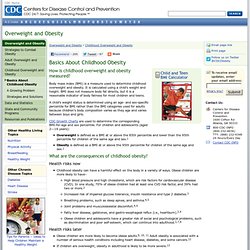

Obesity and Overweight for Professionals: Childhood: Basics - DNPAO - CDC. How is childhood overweight and obesity measured?

Body mass index (BMI) is a measure used to determine childhood overweight and obesity. It is calculated using a child's weight and height. BMI does not measure body fat directly, but it is a reasonable indicator of body fatness for most children and teens. A child's weight status is determined using an age- and sex-specific percentile for BMI rather than the BMI categories used for adults because children's body composition varies as they age and varies between boys and girls.
CDC Growth Charts are used to determine the corresponding BMI-for-age and sex percentile. Overweight is defined as a BMI at or above the 85th percentile and lower than the 95th percentile for children of the same age and sex.1Obesity is defined as a BMI at or above the 95th percentile for children of the same age and sex.1 What are the consequences of childhood obesity?
Health risks now Childhood obesity can have a harmful effect on the body in a variety of ways. P200811131521351363566672. McDonald's Global Sites. Americans becoming more overweight. Preserving Cabrini-Green's images In the sharp sun of an April afternoon, Nate Lanthrum walks through the remains of Cabrini-Green giving away what he has taken.

He looks out of place, a white guy carrying a $1,500 Nikon D700 camera, but the residents are used to him by now and greet... Blackhawks thrilled to have Brent Seabrook back Starting with Game 6 Sunday, Brent Seabrook's timeout will be over and the defenseman will be back on the ice — so long as he promises to play nice. The Blackhawks have done pretty well in Seabrook's absence, winning all three games the NHL... NFL draft preview: Defensive ends As the NFL draft nears — it takes place May 8-10 — we're taking an 11-day, position-by-position look at what's out there and what the Bears need.
In May 1974, Tribune delivered 2 Watergate bombshells Obama denounces racist comments reportedly made by NBA owner. America Keeps Getting Fatter. <br/><a href=" US News</a> | <a href=" Business News</a> Copy Despite the bombardment of news about the dangers of obesity and the billions of dollars poured into healthy choice programs, America is getting fatter.

A new report from Trust for America's Health, a nonpartisan advocacy group, and the Robert Wood Johnson Foundation, found that not one state has reported a decrease in obesity. In fact, adult obesity rates have increased in 16 states in the past year. "Obesity is one of the most challenging health crises this country has ever faced," said Jeff Levi, executive director of Trust for America's Health. In other words, Colorado, which today is the state with the lowest obesity rate, would have had the highest in 1995. Southern states have the highest rates of obesity, and Mississippi tops the nation's list as the largest state, where 34 percent of the population is obese. "State by state, obesity rates are unacceptably high," said Dr. Americans Are Fat, And Expected To Get Much Fatter : Shots - Health Blog. Hide captionOverweight guys will have even more company in a few years.
Justin Sullivan/Getty Images Overweight guys will have even more company in a few years. In case you haven't noticed, we're fat, and getting fatter. If Americans stay on this path, 83 percent of men will be overweight or obese by 2020. Women are right behind them, with 72 percent projected to be overweight or obese by then. The implications go far beyond tight pants and groaning sofas.
Imagining an America of overweight, unhealthy people gives public health officials the willies. The latest numbers come from Mark Huffman, an assistant professor of preventive medicine and cardiology at Northwestern University who presented them at the annual scientific meeting of the American Heart Asssociation this week. He looked at current rates for cardiovascular risk factors including smoking, lack of exercise, diet, weight, blood pressure and cholesterol.
"It's really striking," Huffman told Shots. Clearly we need some help.